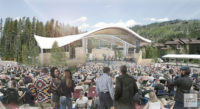Ten years after rising in stadiums across the world as the touring stage for international rock band U2 during the group’s 360 Tour from 2009 to 2011, the 165-ft-tall, four-legged stage structure formerly known as The Claw has been erected as a permanent landmark at the Loveland Living Planet Aquarium (LLPA) in Draper, Utah, about 20 miles south of Salt Lake City.
The steel structure has been rebranded as the Ecosystem Exploration Craft Observatory, or EECO, now part of an estimated $35-million expansion of the aquarium. The work includes an 80,000-sq-ft Science Learning Center, an outdoor amphitheater, as well as outdoor exhibits and gathering spaces on nine acres of property near the existing facility.
The LLPA is expanding its physical footprint and education mission about life on earth and the ecosystems that connect things, according to Brent Andersen, the facility’s founder and CEO.
“A lot of places have some kind of iconic structure to identify them, and I wanted something with a scale that would evoke emotion and curiosity in what we are doing,” Andersen says.
Originally designed by British architect Mark Fisher and Atelier One Structural Engineers of London, the imposing EECO is being reused rather than scrapped, in accordance with the aquarium’s focus on sustainability.
Lyle Beecher, principal at Beecher Walker Architects in Holladay, Utah, and the architect of record for the LLPA, says the EECO is a defining feature not only for the aquarium but also for the south end of the Salt Lake Valley.
“This is part of an exciting project. Downtown Salt Lake City has always had its own energy and excitement and now the south end of the valley is becoming another epicenter for experiences and entertainment,” says Walker, who was also the architect of the Hale Center Theatre, completed in summer 2017 in nearby Sandy. “Architecturally, this defines and creates space for new experiences here at the aquarium.”
Making It Fit
The EECO spans about 28,287 sq ft of space. Anderson said he first saw the steel structure in Barcelona, Spain, when U2 launched the 360 tour in 2009 and again when the band played a concert at the Rice-Eccles Stadium at the University of Utah.
Four different Claw stages were built for the world tour, and Andersen says the one installed at the aquarium was last used in Pittsburgh. Since then, it had been stored in rural Pennsylvania. Andersen says he contacted the tour operators, who still owned the stage, and began the long process of investigating the possibility of buying it and making it a permanent fixture at the LLPA.
“I read an article where Mark Fisher said there had been discussions with the band about putting one of the four stages somewhere permanently in a public venue, but nothing had come of it,” he says. “I just remembered the excitement and the strong reaction I got seeing it and just felt it could have another life and do kind of the same thing here. The big challenge for me was figuring a way to make it fit, not only on this site but with our mission of education.”
Andersen estimates that purchasing, transporting and making modifications to the structure has cost approximately $2 million.
Modifications and Upgrades
Sections of canvas stretched across parts of the Claw’s frame had to be replaced and strengthened to withstand snow loads, and new LED lighting was installed. The steel was sandblasted and repainted, according to John Ragan, owner of Complete Contracting Co., which oversaw construction of the first phase of the aquarium in 2017 and continues as the CM/GC for the expansion.
Ragan says preparing the Claw to be a permanent feature was the greatest challenge. “This thing had never been permanent, so preparing the site and getting precisely where the footings needed to go was critical,” Ragan says. “We had computer and 3D models, and I was lucky to get the engineers in London and Colombia, who worked on this originally, to help us out and get the measurements and details we needed in order to make this work.”
Locally, Ragan worked with steel fabricators and erectors SME Steel Contractors of West Jordan and Salt Lake City-based structural engineering firm Dunn Associates Inc. to develop plans and modify the structure.
“We found out that when the tour was done, they threw some of the parts away, so we had to find out what was missing, and it was a challenge because there are no shop drawings for this. We’ve done a lot of welding,” Ragan says.
Phil Miller, principal at Dunn Associates Inc., says when the stage was erected before, the four legs were connected with a cable system on the ground that could be tensioned to hold them all together.
“But there is going to be a building under it now, so we couldn’t use that cable system here,” Miller says. “We designed a system of piers connected with grade beams below ground to address the horizontal thrust and draw the force down and out to the beams that are in tension.”
Miller says the piers rest on 22-ft-deep spot footings, with 11-ft by 11-ft piers that rise nearly 9 ft above it.
Because the legs of the structure could move while being erected, the precise location of where they needed to rest on the piers was unknown ahead of time, he says.
“There are 8 inch-and-a-half anchor bolts per leg that have to engage with the foot of the structure in its final position. We designed 6-inch corrugated cams under the anchor bolts, and once the bolts are inserted, they can be filled with grout to hold them in the pier.”
With the structure now in place, work on surrounding features, as well as the underground building below the EECO, will continue, Beecher says. That building is scheduled to open next year.



Post a comment to this article
Report Abusive Comment